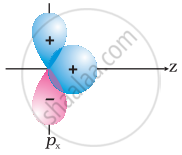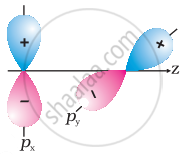Advertisements
Advertisements
प्रश्न
Give reasons for need of Hybridization
उत्तर
The concept of hybridization was introduced because the valence bond theory failed to explain the following points:
- Valencies of certain elements:
The maximum number of covalent bonds which an atom can form equals the number of unpaired electrons present in its valence shell. However, valence bond theory failed to explain how beryllium, boron, and carbon form two, three, and four covalent bonds respectively.
a. Beryllium: The electronic configuration of beryllium is 1s2 2s2. The expected valency is zero (as there is no unpaired electron) but the observed valency is 2 as in BeCl2.
b. Boron: The electronic configuration of boron is 1s2 2s2 \[\ce{2p^1_{{x}}}\]. The valency is expected to be 1 but it is 3 as in BF3.
c. Carbon: The electronic configuration of carbon is 1s2 2s2 \[\ce{2p^1_{{x}}}\] \[\ce{2p^1_{{y}}}\]. The valency is expected to be 2, but the observed valency is 4 as in CH4. - The shapes and geometry of certain molecules:
The valence bond theory cannot explain shapes, geometries, and bond angles in certain molecules.
e.g. a. Tetrahedral shape of a methane molecule.
b. Bond angles in molecules like NH3 (107°18’) and H2O (104°35’).
However, the valency of the above elements and the observe structural properties of the above molecules can be explained by the concept of hybridization. These are the reasons for need of the concept of hybridization.
APPEARS IN
संबंधित प्रश्न
Explain the formation of H2 molecule on the basis of valence bond theory.
Draw an orbital diagram of Fluorine molecule
Display electron distribution around the oxygen atom in the water molecule and state the shape of the molecule, also write the H-O-H bond angle.
Identify the type of overlap present in F2. Explain diagrammatically.
Complete the following Table.
| Molecule | Type of Hybridization | Type of bonds | Geometry | Bond angle |
| CH4 | - | 4C-H 4σ bonds |
Tetrahedral | - |
| NH3 | sp3 | 3N-H 3σ bonds 1 lone pair |
- | - |
| H2O | - | - | angular | 104.5° |
| BF3 | sp2 | - | - | 120° |
| C2H4 | - | - | - | 120° |
| BeF2 | - | 2 Be-F | Linear | - |
| C2H2 | sp | (3σ+2π) 1C-C σ 2C-H σ 2C-C π |
- | - |
Give the type of overlap by which the pi (π) bond is formed.
Mention the steps involved in Hybridization.
The ratio of number of sigma (σ) and pi (л) bonds in 2- butynal is ______.
Which one of the following is the likely bond angles of sulphur tetrafluoride molecule?
According to Valence bond theory, a bond between two atoms is formed when ______.
In ClF3, NF3 and BF3 molecules the chlorine, nitrogen and boron atoms are ______.
When ones and three p orbitals hybridise,
Which of these represents the correct order of their increasing bond order.
XeF2 is isostructural with ______.
Among the following, the compound that contains, ionic, covalent and Coordinate linkage is ______.
Define σ – bond.
Considering x-axis as the molecular axis which out of the following will form a sigma bond.
2px and 2py
Considering x-axis as the molecular axis which out of the following will form a sigma bond.
1s and 2pz
Which of the following molecule contain 50% p-character of hybrid orbital in C atom?
Which of the following is correct decreasing order of the repulsive Interaction of electron pairs in a molecule?
The number of sigma bonds in paracetamol is ____________.
The number of sigma bonds in vanillin is ____________.
If the electronic configuration of an element is 1s2 2s2 2p6 3s2 3p6 3d2 4s2, the four electrons involved in chemical bond formation will be ______.
Why does type of overlap given in the following figure not result in bond formation?
 |
 |
Briefly describe the valence bond theory of covalent bond formation by taking an example of hydrogen. How can you interpret energy changes taking place in the formation of dihydrogen?
